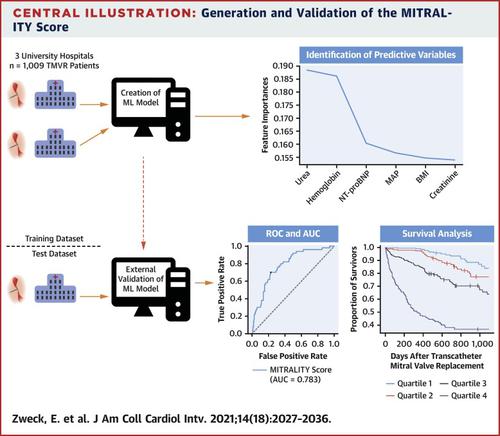JACC: Cardiovascular Interventions ( IF 11.7 ) Pub Date : 2021-09-20 , DOI: 10.1016/j.jcin.2021.06.039 Elric Zweck 1 , Maximilian Spieker 1 , Patrick Horn 1 , Christos Iliadis 2 , Clemens Metze 2 , Refik Kavsur 3 , Vedat Tiyerili 3 , Georg Nickenig 3 , Stephan Baldus 2 , Malte Kelm 1 , Marc Ulrich Becher 3 , Roman Pfister 2 , Ralf Westenfeld 1

|
Objectives
The aim of this study was to develop a machine learning (ML)–based risk stratification tool for 1-year mortality in transcatheter mitral valve repair (TMVR) patients incorporating metabolic and hemodynamic parameters.
Background
The lack of appropriate, well-validated, and specific means to risk-stratify patients with mitral regurgitation complicates the evaluation of prognostic benefits of TMVR in clinical trials and practice.
Methods
A total of 1,009 TMVR patients from 3 university hospitals within the Heart Failure Network Rhineland were included; 1 hospital (n = 317) served as external validation. The primary endpoint was all-cause 1-year mortality. Model performance was assessed using receiver-operating characteristic curve analysis. In the derivation cohort, different ML algorithms were tested using 5-fold cross-validation. The final model, called MITRALITY (transcatheter mitral valve repair mortality prediction system) was tested in the validation cohort with respect to existing clinical scores.
Results
Extreme gradient boosting was selected for the MITRALITY score, using only 6 baseline clinical features for prediction (in order of predictive importance): urea, hemoglobin, N-terminal pro–brain natriuretic peptide, mean arterial pressure, body mass index, and creatinine. In the external validation cohort, the MITRALITY score’s area under the curve was 0.783 (95% CI: 0.716-0.849), while existing scores yielded areas under the curve of 0.721 (95% CI: 0.63-0.811) and 0.657 (95% CI: 0.536-0.778) at best.
Conclusions
The MITRALITY score is a novel, internally and externally validated ML-based tool for risk stratification of patients prior to TMVR, potentially serving future clinical trials and daily clinical practice.
中文翻译:

机器学习识别临床参数以预测接受经导管二尖瓣修复术的患者的死亡率
目标
本研究的目的是开发一种基于机器学习 (ML) 的风险分层工具,用于结合代谢和血流动力学参数的经导管二尖瓣修复 (TMVR) 患者的 1 年死亡率。
背景
缺乏适当的、经过充分验证的和特定的方法来对二尖瓣关闭不全患者进行风险分层,使得临床试验和实践中对 TMVR 预后益处的评估变得复杂。
方法
总共包括来自莱茵兰心力衰竭网络内 3 所大学医院的 1,009 名 TMVR 患者;1 家医院 (n = 317) 作为外部验证。主要终点是全因 1 年死亡率。使用接收者操作特征曲线分析评估模型性能。在推导队列中,使用 5 折交叉验证测试了不同的 ML 算法。最终模型称为 MITRALITY(经导管二尖瓣修复死亡率预测系统)在验证队列中根据现有临床评分进行测试。
结果
为 MITRALITY 评分选择了极端梯度提升,仅使用 6 个基线临床特征进行预测(按预测重要性排序):尿素、血红蛋白、N 端脑钠肽前体、平均动脉压、体重指数和肌酐。在外部验证队列中,MITRALITY 分数的曲线下面积为 0.783(95% CI:0.716-0.849),而现有分数的曲线下面积为 0.721(95% CI:0.63-0.811)和 0.657(95% CI) : 0.536-0.778) 至多。
结论
MITRALITY 评分是一种新的、内部和外部验证的基于 ML 的工具,用于在 TMVR 之前对患者进行风险分层,有可能服务于未来的临床试验和日常临床实践。











































 京公网安备 11010802027423号
京公网安备 11010802027423号